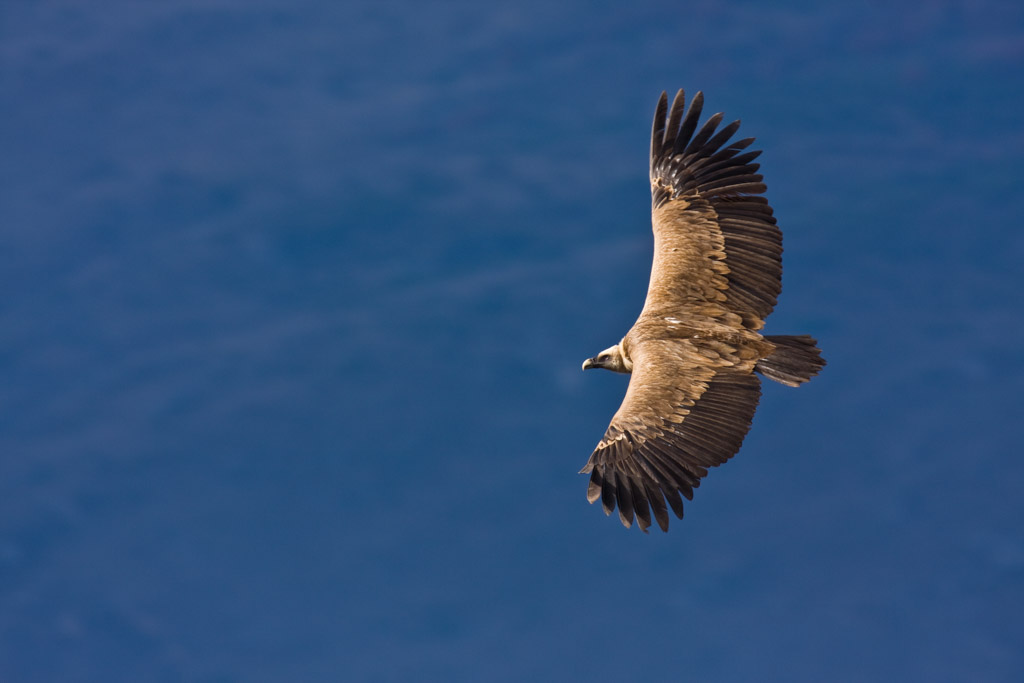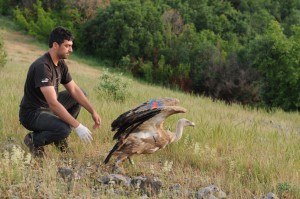Tagged with GPS transmitters, young griffon vultures from the Rhodope Mountains rewilding area continue to make remarkable journeys. As part of the LIFE Vultures project, based in Bulgaria and Greece, such tagging is giving a better understanding of vulture behaviour and aiding in their conservation.

It seems there’s no stopping the international wanderlust of some young Bulgarian griffon vultures. In the spirit of previous voyages by juvenile vultures from the eastern Rhodope Mountains – tagged with GPS transmitters as part of the LIFE Vultures project – two more birds from the area have recently been recorded roaming huge distances. Voyaging separately, the duo even took the opportunity to rendezvous on foreign soil, meeting up as fellow nomads on a cliff face in Israel.

The griffon vulture named Arda, who was fitted with a GPS transmitter in the Rhodopes Mountains rewilding area in 2016, is now a seasoned traveller. This autumn, for a third consecutive year, the young bird undertook a long journey to the southeast, having seemingly chosen the Middle East as “his” winter retreat of choice (determining the sex of vultures is very difficult).
From October 1 until November 1, Arda travelled an astonishing 3250 kilometres, overflying large parts of Turkey, Syria, Jordan and Israel. The itinerant youngster is now in the rocky mountains of northwestern Saudi Arabia, in Tabuk Province, which is territory the bird already knows well.
“The area must appeal to him, as Arda has spent the last two winters in northern Saudi Arabia,” explains Dobromir Dobrev, a vulture expert attached to the Rewilding Rhodopes team.
GPS transmitters fitted as part of the LIFE Vultures project have revealed that such long and potentially dangerous journeys are not unusual for immature griffons. In the autumn of 2016, just a few months after his transmitter was fitted, Arda first wintered in Saudi Arabia and then spent the subsequent summer in northeast Turkey, close to the border with Georgia and Armenia. At the end of 2017, he began his migration south, again overwintering in the Arabian Desert.
Satellite data shows that this year other griffons tagged through the LIFE Vultures project have also preferred to head south as winter approaches. Kaya, who was fitted with a transmitter last year, started her journey in Dadia National Park in Greece, flying over 4000 kilometres between October 1 and November 1. “She” was captured by an Israeli vulture conservation team on November 5, who found her to be in great shape, and is currently still in Israel after her release.
Perhaps even more remarkable than their individual journeys is the fact that Arda and Kaya actually met while travelling, in place called Metsukei HaTsinim Reserve in southern Israel.
“Kaya landed on a mountain cliff in the reserve on November 3 at 1330,” explains Jelle Harms, Rewilding Europe’s GIS Data Manager. “Arda arrived at the same location (within 50 metres) half an hour later. The following day Arda left for Jordan, while Kaya stayed in the area.”
The journeys of Arda, Kaya and other vultures tagged through the LIFE Vultures project (a group comprising both griffon and black vultures) can be followed on the Rewilding Rhodopes website here.
A video showing the remarkable journeys of Arda and Kaya in the autumn of 2018:
Griffon vultures reach maturity in their fifth year. During immaturity they often migrate and cover considerable distances, either indivdually or in small groups. The need for better conditions and food is usually not the reason for this behaviour.
This tendency to travel is not without risk: nearly three-quarters of griffon vulture deaths occur during this roaming period, with the birds crossing unknown and difficult habitats without the support of their colony. They may have difficulty finding food, or collide with power lines, or even fly through dangerous airspace (Kaya crossed over the Syrian city of Aleppo), for example.
Starting in 2016, the five-year LIFE Vultures project was developed by Rewilding Europe, in collaboration with the Rewilding Rhodopes Foundation, the Bulgarian Society for the Protection of Birds (BSPB), and a range of other partners. Focusing on the Rhodope Mountains rewilding area in Bulgaria, as well as a section of the Rhodope Mountains in northern Greece, the aim of the project is to support the recovery and further expansion of the black and griffon vulture populations in this part of the Balkans, mainly by improving natural prey availability, and by reducing mortality through factors such as poaching, poisoning and collisons with power lines.

Essential to maximising the success of the LIFE Vultures project is the tagging of black and griffon vultures with GPS transmitters. As GPS data is systematically fed into a Geographic Information System (GIS), together with a range of other variables, so the rewilding team and their partners are gaining groundbreaking insight into the movement of vulture populations in the monitoring area, the various threats that they face, and the best ways to support the birds’ comeback.
The Rewilding Rhodopes team will continue to follow Arda and his family members as long as possible, to better understand the conditions and population dynamics of the Madzharovo breeding colony (located in the Rhodope Mountains rewilding area). We will keep you updated on their aerial exploits!
